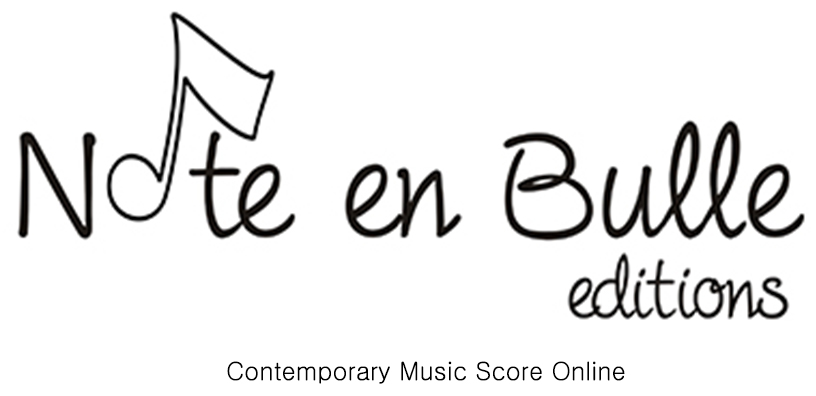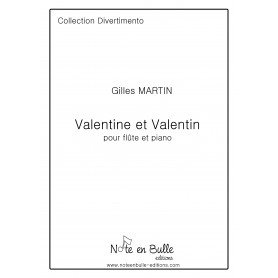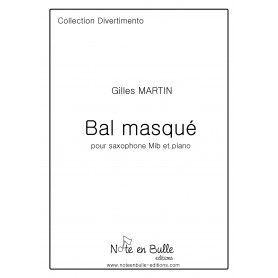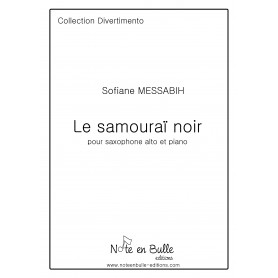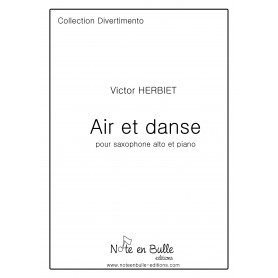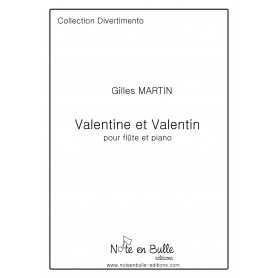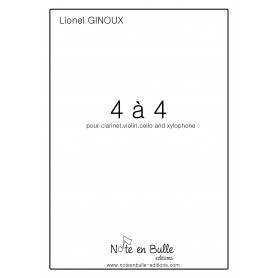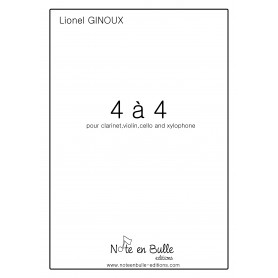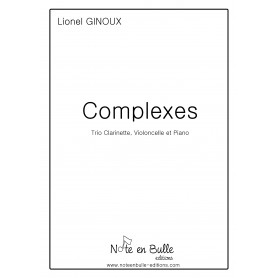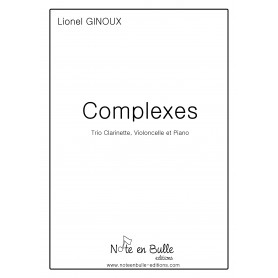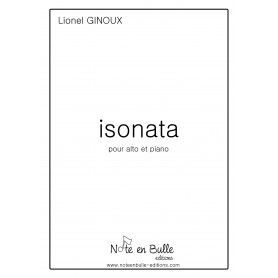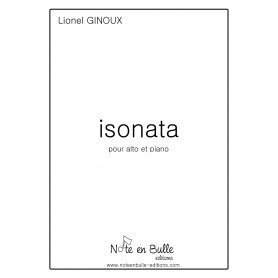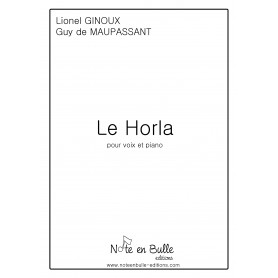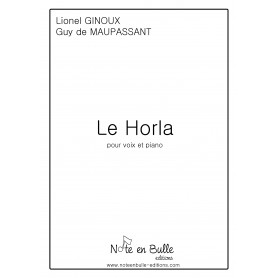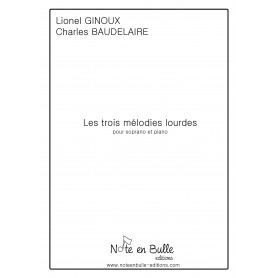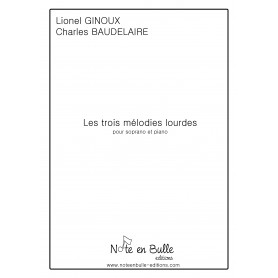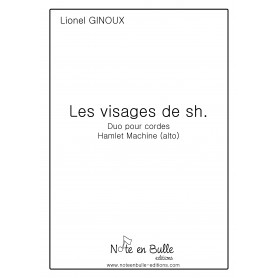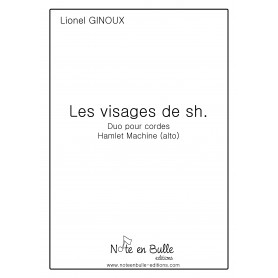Musique de chambre
There are 20 products.
Lionel Ginoux 4 à 4 - pdf
Version PDF
4 à 4
Clarinet, Violin, Cello and Xylophone
Duration 4'30
4 à 4 reveals multiple instrumental timbres and colors and also different techniques of attack: air and breath for the clarinet, the bowing of the violin and cello, and the percussive sound and distinct and precise attack of the xylophone. The four instruments mix perfectly in polyphony with homorhythmic passages, allowing surprising sonorities to spring forth.
Printed paper, click here
4 à 4
Clarinet, Violin, Cello and Xylophone
Duration 4'30
4 à 4 reveals multiple instrumental timbres and colors and also different techniques of attack: air and breath for the clarinet, the bowing of the violin and cello, and the percussive sound and distinct and precise attack of the xylophone. The four instruments mix perfectly in polyphony with homorhythmic passages, allowing surprising sonorities to spring forth.
Printed paper, click here
15.00
Lionel Ginoux 4 à 4 Version papier
4 à 4
Clarinet, Violin, Cello and Xylophone
Duration 4'30
4 à 4 reveals multiple instrumental timbres and colors and also different techniques of attack: air and breath for the clarinet, the bowing of the violin and cello, and the percussive sound and distinct and precise attack of the xylophone. The four instruments mix perfectly in polyphony with homorhythmic passages, allowing surprising sonorities to spring forth.
Clarinet, Violin, Cello and Xylophone
Duration 4'30
4 à 4 reveals multiple instrumental timbres and colors and also different techniques of attack: air and breath for the clarinet, the bowing of the violin and cello, and the percussive sound and distinct and precise attack of the xylophone. The four instruments mix perfectly in polyphony with homorhythmic passages, allowing surprising sonorities to spring forth.
30.00
Lionel Ginoux Complexes - Version papier
Complexes
Clarinet, Cello and Piano
Duration 05'00
Complexes is a composition born from the pictorial grammar Kandinsky used in the painting Two complexes. The concept is to structure the piece and to construct musical substance according to the three pictorial elements of the painting: the dot, the line and the curve.The dot is a cluster, a static compact sound object.The line is born from movement and is dynamic.The curve is represented by appoggiaturas that, like luminous flashes, represent a movement in circles.
Clarinet, Cello and Piano
Duration 05'00
Complexes is a composition born from the pictorial grammar Kandinsky used in the painting Two complexes. The concept is to structure the piece and to construct musical substance according to the three pictorial elements of the painting: the dot, the line and the curve.The dot is a cluster, a static compact sound object.The line is born from movement and is dynamic.The curve is represented by appoggiaturas that, like luminous flashes, represent a movement in circles.
30.00
Lionel Ginoux Complexes - Version PDF
PDF download
Complexes
Clarinet, Cello and Piano
Duration 05'00
Complexes is a composition born from the pictorial grammar Kandinsky used in the painting Two complexes. The concept is to structure the piece and to construct musical substance according to the three pictorial elements of the painting: the dot, the line and the curve.The dot is a cluster, a static compact sound object.The line is born from movement and is dynamic.The curve is represented by appoggiaturas that, like luminous flashes, represent a movement in circles.
Audio
Printed Version, Click here
Complexes
Clarinet, Cello and Piano
Duration 05'00
Complexes is a composition born from the pictorial grammar Kandinsky used in the painting Two complexes. The concept is to structure the piece and to construct musical substance according to the three pictorial elements of the painting: the dot, the line and the curve.The dot is a cluster, a static compact sound object.The line is born from movement and is dynamic.The curve is represented by appoggiaturas that, like luminous flashes, represent a movement in circles.
Audio
Printed Version, Click here
15.00
Lionel Ginoux Isonata - pdf
Version PDF
isonata
Viola and Piano
duration 17'
Work dedicated to Jérémie Honnoré. Commissioned by the Festival Musique à la Ferme (2014).The starting point for this piece is my passion for the viola and the desire to write a piece for this instrument. The viola therefore has an important role. It takes a special place in this score. The piano "colours" the viola's voice and increases its dramatic intensity.With isonata, I wanted to return not to the known forms of the classical sonata, but to return to the starting point of the creation of this form which was: "to provide instrumental music with a musical equivalent to dramatic action (as in the opera or the concerto) by giving a clear definition of the outline of this action (an easily identifiable climax, a point of maximum tension towards which the parts converge...)". (Charles Rosen). I started from this idea of contrast of musical material, of clarity of form, in order to knead the "classical" sonata form.In isonata, musically my postulate was to superimpose consonant chords (left hand three sound chord, right hand three sound chord) and to use repetition and resonance in order to cut the temporal markers and to work on the musical flow. From these two principles, I created the form and the tension/relaxation of the score by stacking or subtracting musical material.I then increased the title "sonata" of the "i" which is nowadays perhaps an emblematic letter with the iphone, ipad, imac... I thought that this could make sense with modernity. This letter "i" asked me the question, in my creation, of memory and especially of the fact that our knowledge is now dependent on hard disks or other storage devices. We entrust our knowledge and understanding to our machines. This is disturbing because we now learn more to seek than to remember. Aren't memory and language gradually being anaesthetized in favour of our machines? That's a bit like that in this room. The language in isonata is as if atrophied, but it keeps all its strength and power.
Printed version,click here
isonata
Viola and Piano
duration 17'
Work dedicated to Jérémie Honnoré. Commissioned by the Festival Musique à la Ferme (2014).The starting point for this piece is my passion for the viola and the desire to write a piece for this instrument. The viola therefore has an important role. It takes a special place in this score. The piano "colours" the viola's voice and increases its dramatic intensity.With isonata, I wanted to return not to the known forms of the classical sonata, but to return to the starting point of the creation of this form which was: "to provide instrumental music with a musical equivalent to dramatic action (as in the opera or the concerto) by giving a clear definition of the outline of this action (an easily identifiable climax, a point of maximum tension towards which the parts converge...)". (Charles Rosen). I started from this idea of contrast of musical material, of clarity of form, in order to knead the "classical" sonata form.In isonata, musically my postulate was to superimpose consonant chords (left hand three sound chord, right hand three sound chord) and to use repetition and resonance in order to cut the temporal markers and to work on the musical flow. From these two principles, I created the form and the tension/relaxation of the score by stacking or subtracting musical material.I then increased the title "sonata" of the "i" which is nowadays perhaps an emblematic letter with the iphone, ipad, imac... I thought that this could make sense with modernity. This letter "i" asked me the question, in my creation, of memory and especially of the fact that our knowledge is now dependent on hard disks or other storage devices. We entrust our knowledge and understanding to our machines. This is disturbing because we now learn more to seek than to remember. Aren't memory and language gradually being anaesthetized in favour of our machines? That's a bit like that in this room. The language in isonata is as if atrophied, but it keeps all its strength and power.
Printed version,click here
15.00
Lionel Ginoux Isonata - Printed Version
isonata
Viola and Piano
duration 17'
Work dedicated to Jérémie Honnoré. Commissioned by the Festival Musique à la Ferme (2014).The starting point for this piece is my passion for the viola and the desire to write a piece for this instrument. The viola therefore has an important role. It takes a special place in this score. The piano "colours" the viola's voice and increases its dramatic intensity.With isonata, I wanted to return not to the known forms of the classical sonata, but to return to the starting point of the creation of this form which was: "to provide instrumental music with a musical equivalent to dramatic action (as in the opera or the concerto) by giving a clear definition of the outline of this action (an easily identifiable climax, a point of maximum tension towards which the parts converge...)". (Charles Rosen). I started from this idea of contrast of musical material, of clarity of form, in order to knead the "classical" sonata form.In isonata, musically my postulate was to superimpose consonant chords (left hand three sound chord, right hand three sound chord) and to use repetition and resonance in order to cut the temporal markers and to work on the musical flow. From these two principles, I created the form and the tension/relaxation of the score by stacking or subtracting musical material.I then increased the title "sonata" of the "i" which is nowadays perhaps an emblematic letter with the iphone, ipad, imac... I thought that this could make sense with modernity. This letter "i" asked me the question, in my creation, of memory and especially of the fact that our knowledge is now dependent on hard disks or other storage devices. We entrust our knowledge and understanding to our machines. This is disturbing because we now learn more to seek than to remember. Aren't memory and language gradually being anaesthetized in favour of our machines? That's a bit like that in this room. The language in isonata is as if atrophied, but it keeps all its strength and power.
Viola and Piano
duration 17'
Work dedicated to Jérémie Honnoré. Commissioned by the Festival Musique à la Ferme (2014).The starting point for this piece is my passion for the viola and the desire to write a piece for this instrument. The viola therefore has an important role. It takes a special place in this score. The piano "colours" the viola's voice and increases its dramatic intensity.With isonata, I wanted to return not to the known forms of the classical sonata, but to return to the starting point of the creation of this form which was: "to provide instrumental music with a musical equivalent to dramatic action (as in the opera or the concerto) by giving a clear definition of the outline of this action (an easily identifiable climax, a point of maximum tension towards which the parts converge...)". (Charles Rosen). I started from this idea of contrast of musical material, of clarity of form, in order to knead the "classical" sonata form.In isonata, musically my postulate was to superimpose consonant chords (left hand three sound chord, right hand three sound chord) and to use repetition and resonance in order to cut the temporal markers and to work on the musical flow. From these two principles, I created the form and the tension/relaxation of the score by stacking or subtracting musical material.I then increased the title "sonata" of the "i" which is nowadays perhaps an emblematic letter with the iphone, ipad, imac... I thought that this could make sense with modernity. This letter "i" asked me the question, in my creation, of memory and especially of the fact that our knowledge is now dependent on hard disks or other storage devices. We entrust our knowledge and understanding to our machines. This is disturbing because we now learn more to seek than to remember. Aren't memory and language gradually being anaesthetized in favour of our machines? That's a bit like that in this room. The language in isonata is as if atrophied, but it keeps all its strength and power.
22.00
Lionel Ginoux le Horla - pdf
PDF download
Le Horla
Voix et Piano
Durée 05'00
At the request of singer Marc Filograsso, Lionel Ginoux based his work on the dream. From an excerpt from Guy de Maupassant’s Horla, the composer describes the precise and disturbing moment when we wake up and where the nightmare persists. You don’t know if you’re awake or still sleeping…
Printed version papier, click here
Le Horla
Voix et Piano
Durée 05'00
At the request of singer Marc Filograsso, Lionel Ginoux based his work on the dream. From an excerpt from Guy de Maupassant’s Horla, the composer describes the precise and disturbing moment when we wake up and where the nightmare persists. You don’t know if you’re awake or still sleeping…
Printed version papier, click here
10.00
Lionel Ginoux le Horla - printed version
Le Horla
Voix et Piano
Durée 05'00
At the request of singer Marc Filograsso, Lionel Ginoux based his work on the dream. From an excerpt from Guy de Maupassant’s Horla, the composer describes the precise and disturbing moment when we wake up and where the nightmare persists. You don’t know if you’re awake or still sleeping…
17.00
Lionel Ginoux les trois mélodies lourdes - pdf
PDF download
Les trois mélodies lourdes
Voice and Piano
Duration 19'50
Les poèmes condamnés (the condemned poems) from Charles Baudelaire are always disturbing in truth about human, the pleasure of the body, the desire for enjoyment, the power of the sexual act. These are magnificent poems that Lionel Ginoux had a happiness to write into music. The words power, enjoyment, voluptuousness, eroticism, sensuality guided his writing in this new score…
Printed version, clik here
Les trois mélodies lourdes
Voice and Piano
Duration 19'50
Les poèmes condamnés (the condemned poems) from Charles Baudelaire are always disturbing in truth about human, the pleasure of the body, the desire for enjoyment, the power of the sexual act. These are magnificent poems that Lionel Ginoux had a happiness to write into music. The words power, enjoyment, voluptuousness, eroticism, sensuality guided his writing in this new score…
Printed version, clik here
10.00
Lionel Ginoux les trois mélodies lourdes - printed version
Les trois mélodies lourdes
Soprano Voice and Piano
Duration 19'50
Les poèmes condamnés (the condemned poems) from Charles Baudelaire are always disturbing in truth about human, the pleasure of the body, the desire for enjoyment, the power of the sexual act. These are magnificent poems that Lionel Ginoux had a happiness to write into music. The words power, enjoyment, voluptuousness, eroticism, sensuality guided his writing in this new score…
17.00
Lionel Ginoux Les visages de sh, Hamlet Machine - pdf
PDf download
Les visages de sh, Hamlet Machine
Violas Duets
Duration 04'30
This alto duo progressively goes through three different atmospheres. Developing from homorhythm, to a ramdom section with free sequences, up to the final part, which is energetic, sustained, and nearly electric.
Printed Version, click here
Les visages de sh, Hamlet Machine
Violas Duets
Duration 04'30
This alto duo progressively goes through three different atmospheres. Developing from homorhythm, to a ramdom section with free sequences, up to the final part, which is energetic, sustained, and nearly electric.
Printed Version, click here
7.00
Lionel Ginoux Les visages de sh, Hamlet Machine- sheet paper
Les visages de sh, Hamlet Machine
Violas Duets
Duration 04'30
This alto duo progressively goes through three different atmospheres. Developing from homorhythm, to a ramdom section with free sequences, up to the final part, which is energetic, sustained, and nearly electric.
16.00
